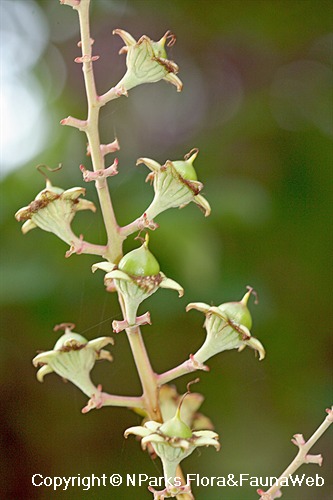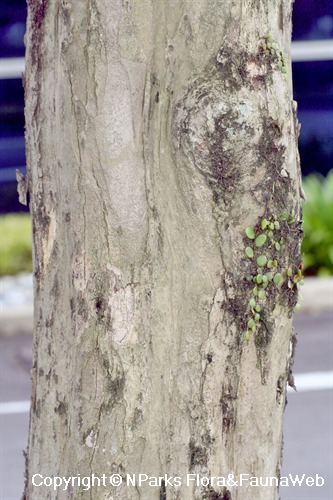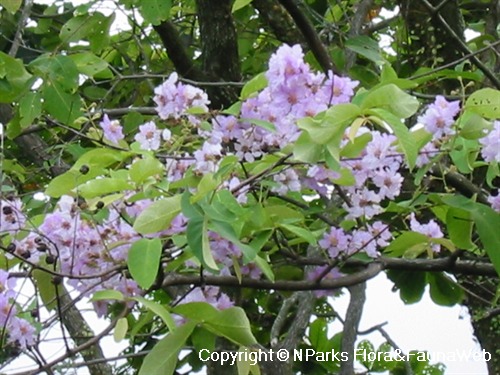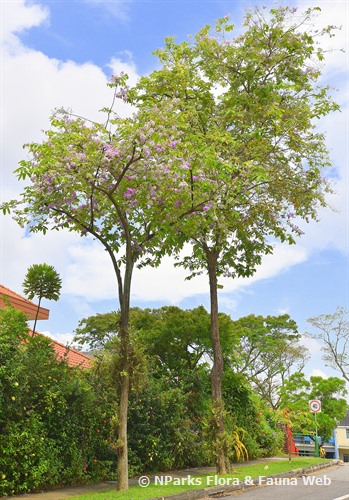
Back
Lagerstroemia speciosa (L.) Pers.
| Family Name: | Lythraceae |
| Synonyms: | Ammania speciosa, Lagerstroemia regina, Lagerstroemia flos-reginae |
| Common Name: | Pride of India, Rose of India, Queen's Crape Myrtle, Crepe Myrtle, Crepe Flower, Queen Flower, Banaba, Pyinma, Bungur Raya, Bungor Raya, Bungor, 大花紫薇 |
Name
Classifications and Characteristics
| Plant Division | Angiosperms (Flowering Seed Plants) (Dicotyledon) |
|---|---|
| Plant Growth Form | Shrub, Tree (Small (6m-15m)) |
| Lifespan (in Singapore) | Perennial |
| Mode of Nutrition | Autotrophic |
| Plant Shape | Rounded |
| Maximum Height | 30 m |
Biogeography
| Native Distribution | Indian Subcontinent, Southern China, Indochina, Philippines, Malaysia, Indonesia. |
|---|---|
| Native Habitat | Terrestrial (Secondary Rainforest, Riverine, Grassland / Savannah/ Scrubland) |
| Preferred Climate Zone | Tropical, Sub-Tropical / Monsoonal, Temperate |
Description and Ethnobotany
| Growth Form | Small tree or big shrub, usually up to 30 m. Crown dense, broadly conical when young; becoming rounded, relatively low and pendulous in older trees, as terminal branch growth is halted by every blooming episode. Greater tree heights attained under more forested conditions, where blooming is delayed as a result of more abundant moisture. |
|---|---|
| Trunk | Often fluted, bark creamy-brown to light grey, smooth and peeling in papery flakes; inner bark pale brown and fibrous. |
| Foliage | SImple, opposite, broadly ovate to oblong, somewhat leathery, with prominent abaxial veins. Young leaves emerge glossy red, turning to pinkish and then finally green. Old leaves wither to orange-red before being shed. Tree is drought-deciduous, shedding leaves over a few days or gradually over a few months, depending on severity of dry period. |
| Flowers | Conspicuous, 5-7 cm across; 6 petals, papery-wrinkled and crepe-like, pinkish-purple, fading white and shed 2-3 days later; central disc of stamens numerous, light yellow; pollinated by large bees. Flowers held in elongated panicle inflorescence, 30-40 cm long, sticking out from crown, with individual flowers opening progressively from bottom to top of panicle. Fairly free-blooming in Singapore, occurring several times per year, with flowers appearing with new shoots. Blooming often more spectacular in climates with distinct dry-cool weather, taking place from late summer to autumn. |
| Fruit | Woody dehiscent capsules, globose, around 2 cm across, seated on persistent woody calyx, maturing from green to brown, splitting radially into 6 parts when ripe. Only larger flowers in cluster set fruits. Seeds numerous, small (165,000-235,000 dry seeds/kg), triangular, flattened and apically winged, dispersed by wind. First few leaves of seedlings alternate, becoming sub-opposite, before attaining opposite leaf arrangement of adult form. |
| Habitat | Relatively open sites like secondary or disturbed forests, grassland, and especially along rivers. |
| Cultivation | Prefers moderately fertile, well-drained soils. Drought-tolerant when established, but exhibits lusher growth with regular watering. Remove water-shoots from stems or roots, if plants are used as trees. Crown-pruning usually not necessary, but if needed to improve tree form, prune only after leaves are shed, so as not to interfere with flower bud formation that occurs on new growth. Avoid frequent or annual pruning, as severe pruning may induce excessive foliar growth, basal sprouting, and fewer (though larger) flower panicles. Easily propagated by seeds, softwood and woody stem-cuttings, root-cuttings, and marcotting. Seeds stored in airtight containers with no temperature-control remain viable for 2 years, should be sown in shade, with germination occuring in 15-56 days. Specimens up to 6m tall known to transplant well -- bare-rooted or balled-and-burlapped trees should be moved and planted while not in leaf, mulch base and provide ample irrigation for at least 2 weeks subsequently to aid establishment at new site. |
| Etymology | Genus epithet 'Lagerstroemia' named by Linnaeus (father of modern taxonomy) after Swedish naturalist, director of the Swedish East Indies Company and patron of science, Magnus von Lagerstroem (1696-1759), who supplied his friend Linnaeus with the plant he collected. Species epithet 'speciosa' means 'showy' or 'spectacular'. |
| Ethnobotanical Uses | Food (Herb or Spice) Others: Timber: Provides a reddish-brown wood called pyinma. Regarded as similar to teak (Tectona grandis) in characteristics, moderately hard and durable, with termite-resistant heartwood -- wooden stakes used in ground known to last for about 7 years. Used in medium-heavy construction, such as for bridges, wharves, boats, mine struts and railway sleepers, as well as panelling, parquet flooring, paddles, agricultural tools and handicrafts. Also source of good firewood. Forestry: Trees used as physical support for climbing-rattan in Kalimantan, Indonesia. Medicinal: Bark used to treat diarrhoea and abdominal pain in Malaysia, Indonesia, Philippines, Taiwan and Japan. Leaves and dried fruits traditionally made into herbal tea (known as Banaba Tea in Philippines, after tree's Tagalog name) to treat high blood pressure, diabetes and kidney ailments (eg. dissolving kidney stones). Plant extracts available as health supplements, purportedly effective for blood sugar control and weight loss. Modern medical research shows that leaf extracts have hypoglycemic (glucose-lowering) effects in genetically-diabetic rats, thus suggesting the plant's potential use as anti-diabetic medication. |
Landscaping Features
| Desirable Plant Features | Ornamental Flowers |
|---|---|
| Landscape Uses | Suitable for Roadsides, General, Flowerbed / Border, Shade Providing Tree / Palm |
| Thematic Landscaping | Naturalistic Garden |
Fauna, Pollination and Dispersal
| Pollination Method(s) | Biotic (Fauna) (Insects (Bee)) |
|---|---|
| Seed or Spore Dispersal | Abiotic (Explosive Dehiscence) |
Plant Care and Propagation
| Light Preference | Full Sun |
|---|---|
| Water Preference | Moderate Water |
| Plant Growth Rate | Moderate |
| Rootzone Tolerance | Fertile Loamy Soils, Well-Drained Soils, Drought Tolerant |
| Maintenance Requirements | Moderate |
| Propagation Method | Seed, Stem Cutting, Marcotting |
Foliar
| Foliage Retention | Drought / Semi-Deciduous |
|---|---|
| Mature Foliage Colour(s) | Green |
| Mature Foliage Texture(s) | Smooth, Leathery |
| Foliar Type | Simple / Unifoliate |
| Foliar Arrangement Along Stem | Opposite |
| Foliar Shape(s) | Non-Palm Foliage (Oval, Elliptical) |
| Foliar Venation | Pinnate / Net |
| Foliar Margin | Entire |
| Foliar Apex - Tip | Cuspidate |
| Foliar Base | Rounded / Obtuse |
| Typical Foliar Area | Notophyll ( 20.25cm2 - 45 cm2 ) |
| Leaf Area Index (LAI) for Green Plot Ratio | 3.0 (Tree - Intermediate Canopy) |
| Prominent Young Flush Colour(s) Remarks | Red to pinkish, light orange and light green |
Non - Foliar and Storage
| Trunk Type (Non Palm) | Woody |
|---|---|
| Mature Bark Texture | Peeling / Flaking / Papery |
| Stem Type & Modification | Woody |
| Root Type | Underground (Tap Root, Fibrous Root) |
Floral (Angiosperm)
| Flower & Plant Sexuality | Bisexual Flowers |
| Flower Colour(s) | Pink, Purple |
|---|---|
| Flower Symmetry | Radial |
| Flower Size - Remarks | 5-7 cm across |
| Inflorescence Type | Panicle |
| Flower Lifespan on Plant | [Remarks] (2-3 days) |
| Flower Lifespan on Plant - Remarks | 2-3 days |
| Flowering Habit | Polycarpic |
| Flowering Period Remarks | Several times per year |
Fruit, Seed and Spore
| Mature Fruit Colour(s) | Brown |
|---|---|
| Fruit Classification | Simple Fruit |
| Fruit Type | Dehiscent Dry Fruit , Capsule |
Image Repository
Others
| Master ID | 1698 |
|---|---|
| Species ID | 2991 |
| Flora Disclaimer | The information in this website has been compiled from reliable sources, such as reference works on medicinal plants. It is not a substitute for medical advice or treatment and NParks does not purport to provide any medical advice. Readers should always consult his/her physician before using or consuming a plant for medicinal purposes. |






























